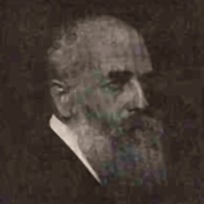Physician, Anthropologist, Ethnologist, Archaeologist. Born Hollabrunn (Austria) 11 August 1854, died Berlin (Germany) 7 February 1924. A man of extraordinary broad education (his academic degrees are M.D., Litt. D. and D. Sc. from Vienna University as well as a D. phil. from Munich University), Luschan was first noted for his excavations in Sendschirli (Zinzirli, Turkey; Die Ausgrabungen in Sendschirli).
Over thirty years of detailed archaeological and anthropometric fieldwork led him to establish a diachronic anthropological classification of the inhabitants of Asia Minor (Die anthropologische Stellung der Juden, The Early Inhabitants of Western Asia). Subsequently, he developed a liberal race theory in which he introduced the word "Pygmäen" and the notion of 'convergence' into anthropological terminology (Die Nilländer, Wissen der Gegenwart, Zusammenhänge und Convergenz).
Luschan denied the existence of an anthropologically uniform "Jewish race", ridiculing the Aryan origins theory then popular in Germany by proving that the distinctive features of the so-called "Jewish type" descended directly from the ancient Hetites, which belonged to the the ancient Armenian race and thus, were the closest relatives of the "Aryans". He also strongly objected to the popular classification of human races into "superior" and "inferior" on the basis of colour or other criteria (with special reference to Africans). Luschan dismissed such terms as "fetish" and "savages", claiming that the only savages in Africa were the whites (Anthropological View of Race, Anleitungen für ethnographische Beobachtungen, Völker, Rassen, Sprachen).
As full professor of anthropology at the Berlin university from 1909-22 he was the forerunner of the disciplines of anthropobiology and human genetics. His radical social darwinism did not contribute to his popularity, and today Luschan's recognition relies chiefly upon his activities as curator and later director of the Berliner Völkerkunde Museum (1885-1910), which he had provided with unprecedented scientific descriptions of its ethnographic holdings and for which he acquired the most complete collection of Benin art ever assembled. By 1901 he had established himself as an expert on Benin with several publications, whereby he emphasized its genuine African origin and its value for world culture (Altertümer von Benin, Bruchstücke einer Beninplatte, Über die alten Handelsbeziehungen von Benin, Karl Knorrsche Sammlung von Benin Altertümern). His monumental Die Altertümer von Benin remains the standard reference work on this subject.
(text written by Malgorzata Irek, by courtesy of Berthold Riese; photo source: http://www.ezakwantu.com/Gallery%20Herero%20and%20Namaqua%20Genocide.htm)



